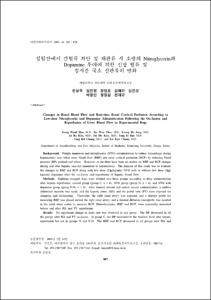KUMEL Repository
1. Journal Papers (연구논문)
1. School of Medicine (의과대학)
Dept. of Anesthesiology & Pain Medicine (마취통증의학)
실험견에서 간혈류 차단 및 재관류 시 소량의 Nitroglycerin과 Dopamine 투여에 의한 신장 혈류 및 실시간 국소 신관류의 변화
- Keimyung Author(s)
- Jang, Young Ho; Kim, Ae Ra; Kim, Jin Mo; Bae, Jung In; Chung, Jung Kil; Cheun, Jae Kyu
- Journal Title
- 대한마취과학회지
- Issued Date
- 2003
- Volume
- 44
- Issue
- 6
- Abstract
- Background: Pringle maneuver and nitroglycerin (NTG) administration to reduce hemorrhage during hepatectomy may affect renal blood flow (RBF) and renal cortical perfusion (RCP) by reducing blood pressure (BP), perload and others. However, so far there have been no studies on RBF and RCP changes during and after hepatic vascular maneuver in hepatectomy. The purpose of this study was to evaluate the changes in RBF and RCP along with low dose (2 ^g/kg/min) NTG with or without low dose (3 figj kg/min) dopamine after the occlusion and reperfusion of hepatic blood flow.
Methods: Eighteen mongrel dogs were divided into three groups according to drug administration after hepatic reperfusion; control group (group C, n = 6), NTG group (group N, n = 6),and NTG with dopamine group (group N-D, n = 6). After femoral arterial and central venous catheterization, a midline abdominal incision was made, and the hepatic artery (HA) and the portal vein (PV) were exposed for clamping and declamping. Thereafter, the right renal artery was exposed, and a doppler probe for measuring RBF was placed around the right renal artery, and a thermal diffusion microprobe was inserted in the renal outer cortex to measure RCP. Hemodynamics, RBF and RCP, were repeatedly measured before and after HA and PV reperfusion.
Results: No significant change in heart rate was observed in any group. The BP decreased in all the groups after HA and PV occlusion. In group C, the BP recovered to the baseline level after hepatic reperfusion but not in groups N and N-D. The RBF and RCP decreased in all groups after HA and PV occlusion. The RBF increased compared to baseline in N-D after hapatic reperfusion, and the RCP increased versus baseline in N-D, 10 minutes after hepatic reperfusion. Conclusions: In conclusion, it was observed that the RBF and RCP increased compared to baseline by administering dopamine during HA and PV reperfusion. Therefore, the prophylactic administration of low dose dopamine during hepatectomy offers an effective method of protecting renal function. (Korean J Anesthesiol 2003; 44: 867~876)
- Alternative Title
- Changes in Renal Blood Flow and Real-time Renal Cortical Perfusion According to Low-dose Nitroglycerin and Dopamine Administration Following the Occlusion and Reperfusion of Liver Blood Flow in Experimental Dogs
- Publisher
- School of Medicine
- Citation
- 한성욱 et al. (2003). 실험견에서 간혈류 차단 및 재관류 시 소량의 Nitroglycerin과 Dopamine 투여에 의한 신장 혈류 및 실시간 국소 신관류의 변화. 대한마취과학회지, 44(6), 867–876. doi: 10.4097/kjae.2003.44.6.867
- Type
- Article
- ISSN
- 0302-5780
- Appears in Collections:
- 1. School of Medicine (의과대학) > Dept. of Anesthesiology & Pain Medicine (마취통증의학)
- 파일 목록
-
-
Download
 oak-bbb-842.pdf
기타 데이터 / 236.16 kB / Adobe PDF
oak-bbb-842.pdf
기타 데이터 / 236.16 kB / Adobe PDF
-
Items in Repository are protected by copyright, with all rights reserved, unless otherwise indicated.